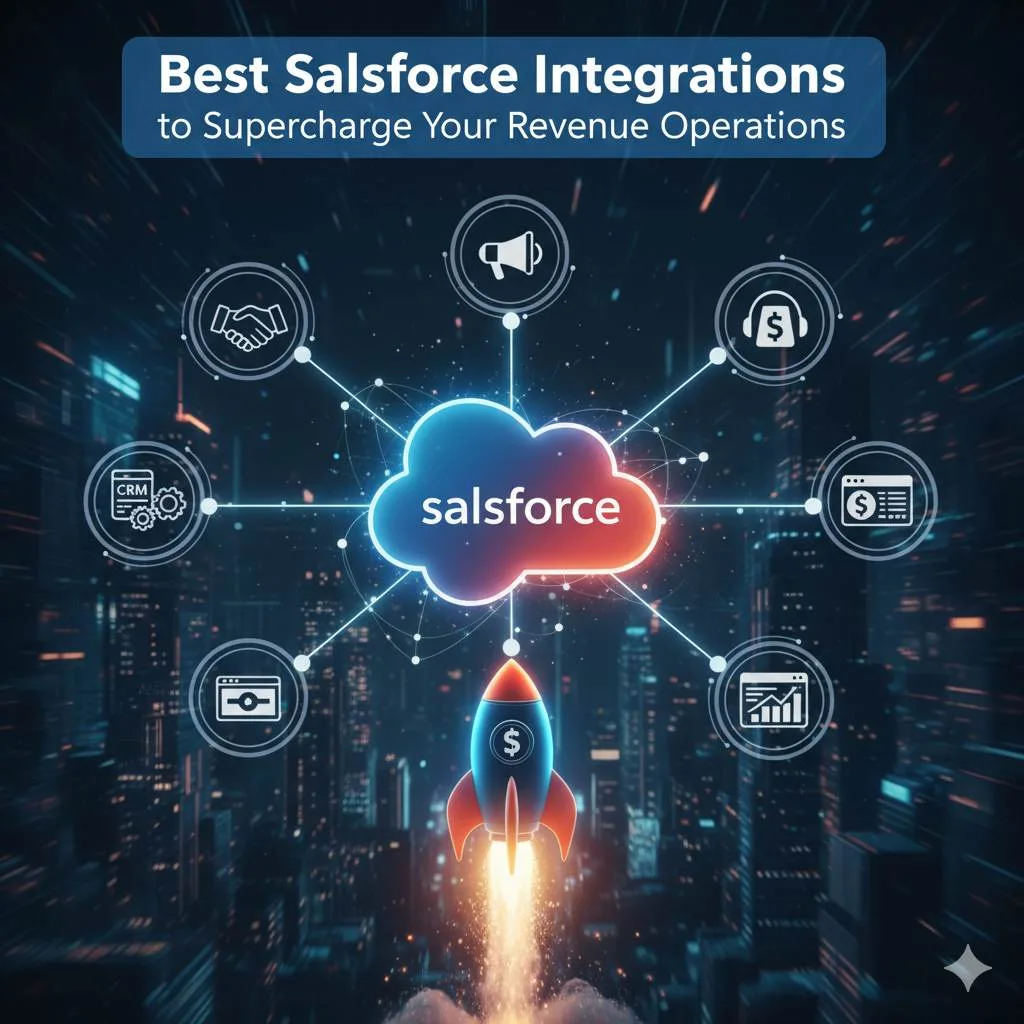Best Salesforce Integrations to Supercharge Your Revenue Operations (Apollo, SharePoint & Marketo Explained)
Modern revenue teams rely on one thing above anything else: clear, connected data. As businesses grow, different teams adopt tools for prospecting, marketing, document management, and analytics. These tools work well on their own, but disconnected data slows down revenue growth, creates gaps in reporting, and limits visibility for both sales and marketing teams.
This is where the right Salesforce integrations make a difference. When Salesforce is connected properly with systems such as Apollo, SharePoint, and Marketo, teams gain a unified flow of information, from first touch to closed deal. In this article, we explore why Salesforce integration matters and break down three of the most impactful integrations for companies looking to strengthen their revenue operations.
Why Salesforce Integrations Matter for Revenue Teams
Salesforce is the central system for managing leads, accounts, and opportunities. But even the strongest CRM needs support from the tools that surround it. Companies rely on platforms for outreach, marketing automation, content storage, communication, and more. When these systems aren’t connected, manual work increases, data becomes unreliable, and insights start to fade.
A solid Salesforce integration strategy reduces these problems. Integrations help teams:
- Keep customer and prospect information updated across systems
- Build accurate forecasting based on real activity
- Improve lead qualification by feeding enriched or scored data into Salesforce
- Strengthen alignment between marketing and sales
- Reduce manual entry and the risk of duplicate or incomplete records
- Provide a consistent customer journey from first engagement to deal management
These advantages help revenue teams work faster and plan with more confidence. And when integrations are done thoughtfully, Apollo, SharePoint, and Marketo become powerful extensions of Salesforce rather than disconnected tools.
Top 3 Salesforce Integrations:
Top 3 Salesforce integrations every revenue team should consider include Apollo.io for enriched prospecting data, Marketo (Adobe) for marketing automation alignment, and Microsoft SharePoint for seamless document and content management.
Apollo.io
Marketo (Adobe)
Microsoft Sharepoint
Apollo Salesforce Integration
The phrase Apollo Salesforce integration refers to connecting Apollo.io, known for data enrichment, prospecting, and sequences, with the Salesforce platform. This integration helps sales and RevOps teams maintain accurate records and reduce time spent researching or manually updating contacts.
Apollo adds value in three main ways:
1. Data Enrichment
Apollo provides verified contact and company information. When synced with Salesforce, this enrichment updates fields like email, phone number, title, company industry, and size. This gives sales teams stronger profiles and more reliable lead scoring.
2. Prospecting and Outreach
SDRs and AEs use Apollo sequences for outreach. When the integration is active, tasks, emails, and call activity can push directly into Salesforce. This strengthens reporting and gives managers a clear picture of pipeline activity.
3. Cleaner Lead Management
When Apollo syncs with Salesforce, duplicate records can be reduced through mapping rules and field controls. Updating lead or contact records from one system automatically reflects in the other.
Best Practices:
- Review field mappings before enabling the sync
- Set rules for which system controls enrichment
- Limit sync direction to avoid overwriting important Salesforce data
- Clean data before activating large-scale syncs
When used responsibly, connecting Apollo and Salesforce improves both data accuracy and workflow consistency for sales teams.
Salesforce Integration with SharePoint
Document management is a core part of sales operations, from proposals to contracts to product sheets. Salesforce integration with SharePoint helps teams organize content without relying on manual uploads or scattered file versions.
SharePoint serves as a secure, enterprise-grade document repository. When integrated with Salesforce, the two systems work together to make document handling easier and more reliable.
Key Benefits:
- Centralized File Storage
Sales and service teams access documents stored in SharePoint directly from Salesforce records. This improves accessibility and reduces confusion over multiple versions of the same file.
- Cross-Team Collaboration
SharePoint allows team members from other departments, legal, finance, and operations, to contribute to or review files without needing Salesforce access.
- Security and Compliance
SharePoint offers flexible permissions, audit trails, and document-level security. Integrating with Salesforce preserves these controls, which is especially important for regulated industries.
Integration Options:
- Native Salesforce SharePoint connectors
- Middleware tools such as MuleSoft or Azure Logic Apps
- Custom integrations using APIs
Businesses choose an integration method based on their governance model, security needs, and document volume. When implemented well, Salesforce and SharePoint help reduce email attachments, outdated files, and inconsistent storage habits across teams.
Marketo with Salesforce Integration
Marketing and sales alignment is difficult when systems don’t speak the same language. This is where Marketo with Salesforce integration becomes valuable. Marketo acts as the marketing automation engine, while Salesforce manages pipeline, sales stages, and post-sale activity.
Connecting them ensures both teams are working with the same information.
What Syncs Between the Two Systems?
- Leads and Contacts
- Campaigns and campaign membership
- Activities such as email engagement
- Lead scores and qualification fields
How This Helps Revenue Teams:
- Stronger Lead Qualification
Marketo can apply scoring based on engagement, demographics, or behaviors, and send only sales-ready leads to Salesforce.
- Reliable Marketing Attribution
Campaign activity from Marketo appears directly on the Salesforce records, giving teams a clearer understanding of what influenced a deal.
- Better Handoffs Between Teams
When Marketo identifies a qualified lead, Salesforce users receive a complete snapshot of that person’s activity history, improving follow-up quality.
Common Challenges to Watch:
- Misaligned field mappings
- Duplicate records
- Permission issues
- Too much data syncing without proper filters
With regular monitoring and clear ownership between teams, Marketo and Salesforce create a more transparent and predictable lead management process.
How to Choose the Right Salesforce
Integration Strategy
Not every business needs every integration. Choosing the right approach depends on:
- The size of your sales and marketing teams
- How complex your data model is
- Whether you store sensitive documents that must meet compliance rules
- Internal skills and the ability to manage ongoing integration and maintenance
- How quickly do you need the integration in place
- Budget, licensing, and future growth plans
Teams should evaluate integrations based on where they will have the most immediate and meaningful impact. For some, this means improving prospecting with Apollo. For others, the priority may be document management with SharePoint or marketing alignment with Marketo.
If you want all three solutions working together in one connected CRM framework, dgt27.com can help. Hire a certified Salesforce developer from dgt27.com to build the right integration strategy for your business.
Final thoughts
Salesforce becomes far more powerful when it works together with the tools that support your sales, marketing, and document workflows. Apollo strengthens prospecting and enrichment. SharePoint improves the way teams manage and access content. Marketo ties marketing engagement directly into the sales process. Each integration fills a specific operational gap, and when combined, they create a stronger, more connected revenue engine.
Businesses that take the time to build thoughtful Salesforce integrations gain better visibility, cleaner data, and more predictable results across their go-to-market teams.







